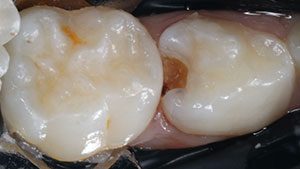Early treatment of carious lesions in deciduous teeth is important for the maintenance of oral health. Nevertheless, in Germany, despite a general decrease in caries, about 30% of all carious lesions apparent in the first dentition of 6-year-olds have not been treated with fillings.1
One reason for this is that those children who show little or very poor home care compliance are also those who are afraid of dental treatment. It is difficult to motivate these children to receive effective treatment. One way of motivating them is to use colored fillings. When it comes to providing an incentive to those children who are less nervous and who simply refuse treatment on principle, the deciding factor is the colored filling.
Using clinical examples, the following reports demonstrate that compliance in children with carious lesions in their deciduous teeth can be greatly improved, and a valid treatment completed, when colored fillings are placed. A special compomer is now commercially available to make this possible.
THE INCENTIVE FOR KIDS: CHOICE OF COLORS
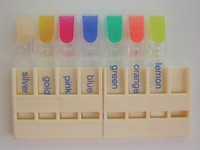 |
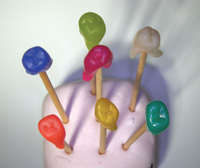 |
| Figure 1. Twinky Star color palette. | Figure 2. Color palette by Dr. Schafer and Silke Roehr. |
Allowing the young patient to choose the color of a restoration gives him or her the opportunity to take part in the procedure. The color options available using Twinky Star compomers (VOCO America) range from a natural tooth color with sparkle, to pink, blue, and green (Figure 1). In order to give the children a better idea of what a tooth with a colored filling looks like, and to make it easier to choose, we have created our own color palette (Figure 2).
Choosing colors makes for an event that leaves a lasting impression. On the next visit the children often ask or inform the dentist, ‘I think I know what color I want, but I’ll have another look just in case I change my mind.’
CLINICAL EXAMPLE
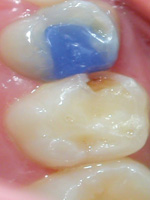 |
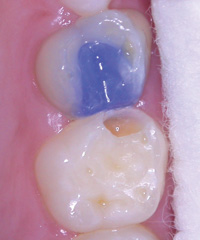 |
| Figure 3. Initial condition of tooth. | Figure 4. Condition following excavation. |
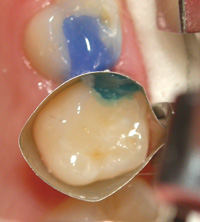 |
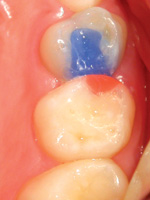 |
| Figure 5. Total etch. | Figure 6. End result. |
It is especially true for young children that they can only tolerate heteronomous behavior for a certain amount of time, leaving only a short time span within which the dentist can perform the procedures. Therefore, the dentist needs to work quickly. The clinical procedure for placing colored restorations involves cavity excavation followed by etching for 60 seconds with 35% orthophosphoric acid (Vococid, VOCO America, Figures 3 to 5). The etched cavity is treated with either Solobond Plus or Solobond M (VOCO America), and the filling material is selected according to the size of the cavity. The material is then applied in one or a series of layers before being light-cured for 40 seconds. The selection of bonding agent and filling material depends on the patient’s cooperation. Finally, the filling is polished using a fine grain diamond and rubber polisher (Figure 6).
THE POLISHING PROCESS
In the case of very young children it is not always possible to polish the filling immediately after insertion, as there is a significant decline in the child’s cooperation as time progresses. In such an event polishing is postponed until a later visit. In some cases the children are so fidgety that polishing is completely omitted. With these children the time span available is so limited that work on other untreated teeth must be a priority. Despite these unpolished restorations not being optimal, we have noticed that the marginal quality is nevertheless very high.
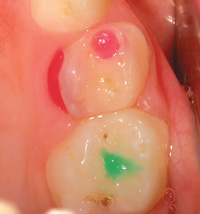 |
| Figure 7. Unpolished palatal and occlusal fillings. |
One 4-year-old female patient did not even tolerate a single polishing instrument in her mouth. The finishing and polishing stages were therefore completely omitted (Figure 7). The palatal filling (Figure 7) was completed following excavation by hand, followed by etching and application of adhesive in single layers, then curing. Six months later the 2 occlusal cavities were treated. In the meantime, the patient allowed treatment using rotating hand instruments. A procedure using water cooling was not yet acceptable, but excavation with a round bur was possible for a very short time. The occlusal filling in one tooth was left similarly unpolished, with the occlusal filling in another tooth being briefly polished with a yellow, fine grain diamond and a synthetic polisher. Despite not having been polished 6 months previously, the palatal filling still showed good marginal adaptation.
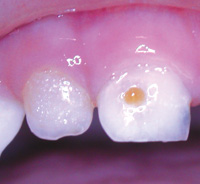 |
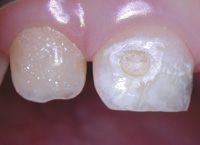 |
| Figure 8. Initial condition of tooth. | Figure 9. Tooth following excavation. Adjacent tooth previously treated using Twinky Star silver. |
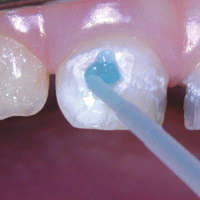 |
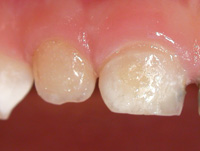 |
| Figure 10. Use of the total-etch process with 35% orthophosphoric acid. | Figure 11. Completed filling using Twinky Star silver. |
In the case of children who have accepted the idea of treatment, colored fillings show very good results. The following is a prime example. One 4-year-old who had already experienced the Twinky Star treatment (Figure 8) was quite happy to receive a second filling in the adjacent tooth (Figure 9). Following total etching (Figure 10), the cavity could be worked on without difficulty (Figure 11).
CONCLUSION
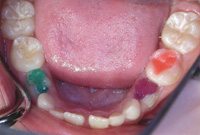 |
| Figure 12. Follow-up after 6 months. |
The examples in this article demonstrate that the use of colored compomers in children can be a valuable motivational tool. The success of the treatment is aided even further by the dentist’s explanation to the children that the fillings will continue to look good as long as the patient properly maintains them. Since the children are usually very proud of their new fillings, the idea is to encourage maintenance of them, so that by educating both children and parents a significant improvement in general oral hygiene is achieved. At the 6-month follow-up visit it was noted that those children who first appeared with multiple carious lesions and a high degree of caries were now showing only a few new carious lesions in comparison. Figure 12 is a good example, which shows results at the 6-month follow-up visit. When the tooth was filled at the start of treatment, the patient was only moderately cooperative (the patient appeared at the clinic with a toothache). During the following 3 visits, 2 teeth were sealed and 2 teeth received fillings. Acceptance grew with each visit, so that by the end of treatment a satisfactory filling in another tooth could be placed.
Reference
1. Kr’er N, Frankenberger R. F’lungstherapie im milchgebiss. Oralprophylaxe & Kinderzahnheilkunde. 2004;2:78-84.
Dr. Schafer is a dentist in the department for periodontology, operative and preventive dentistry at the University of Bonn in Germany. She can be reached at Christine.Schaefer@ ukb.uni-bonn.de.







